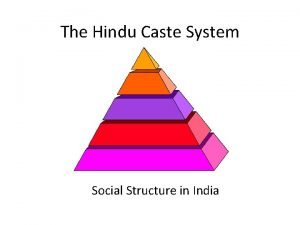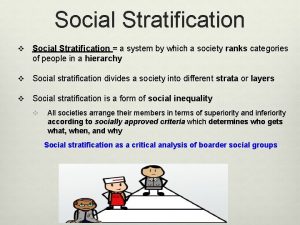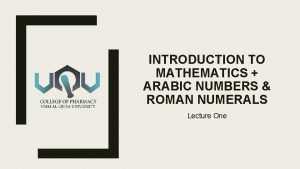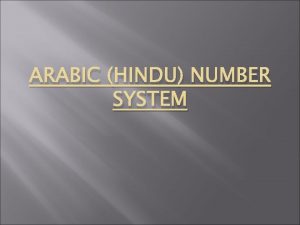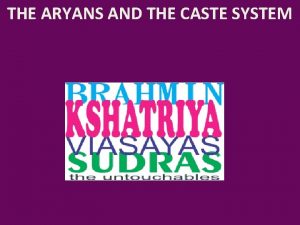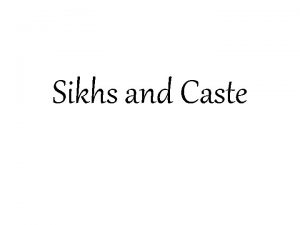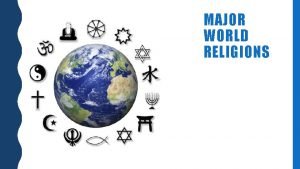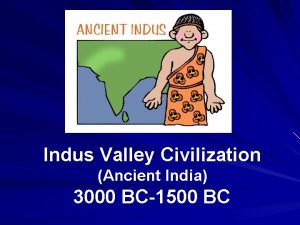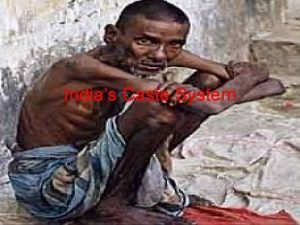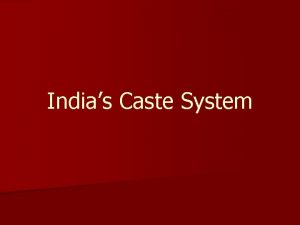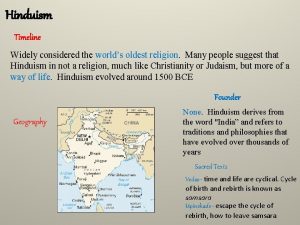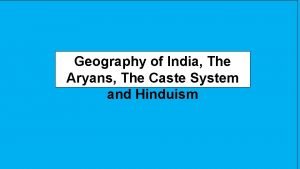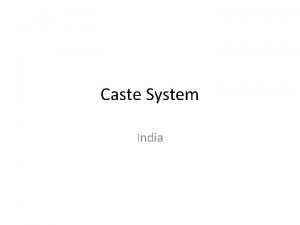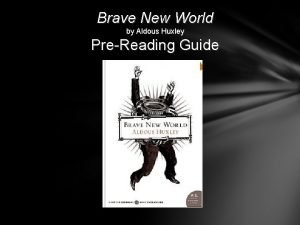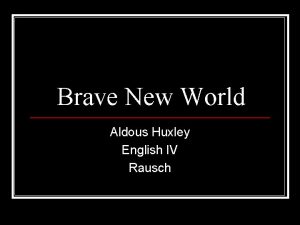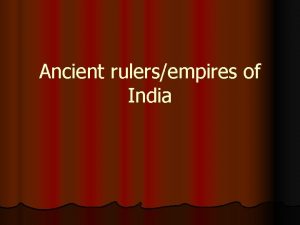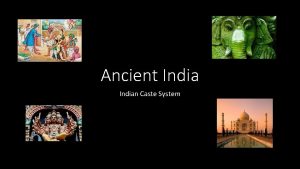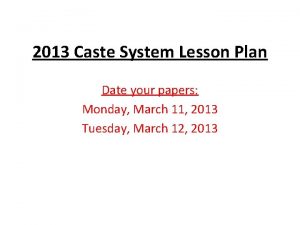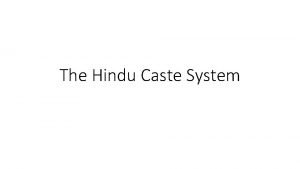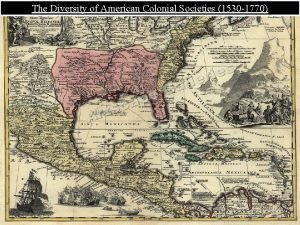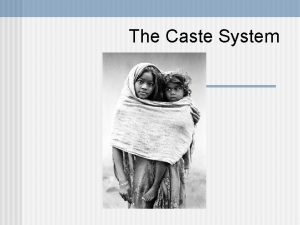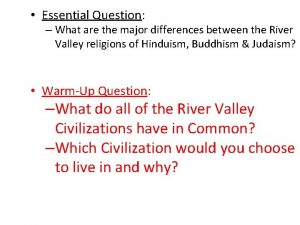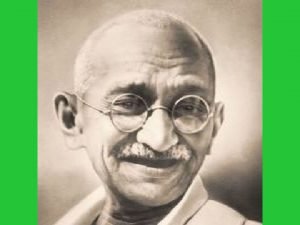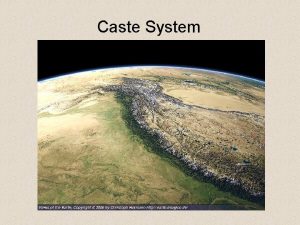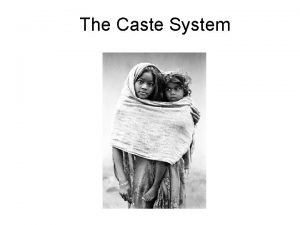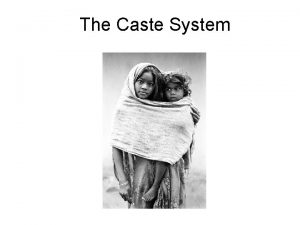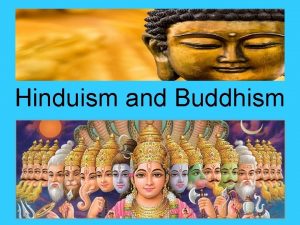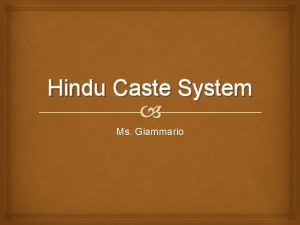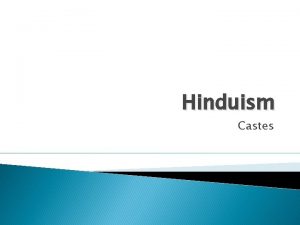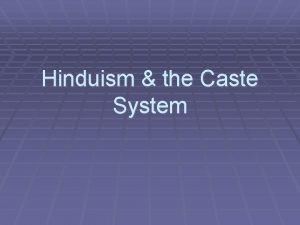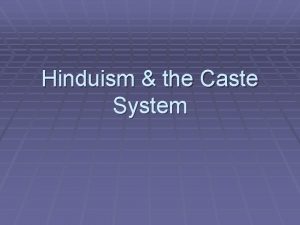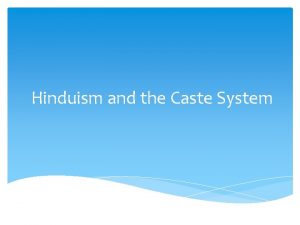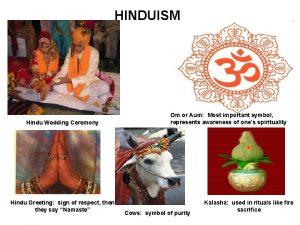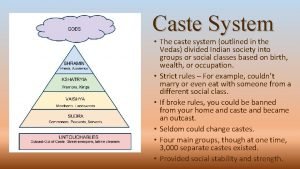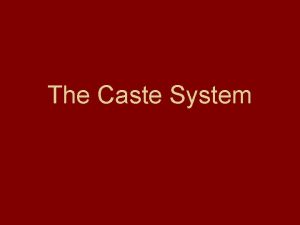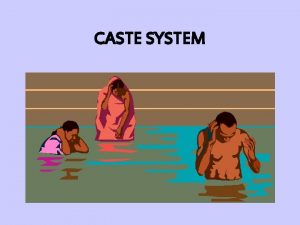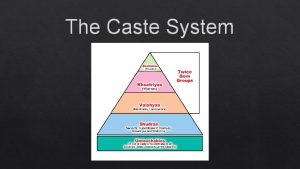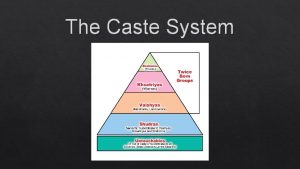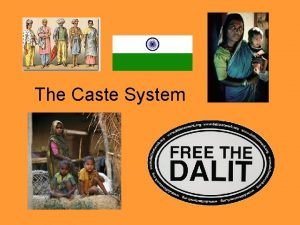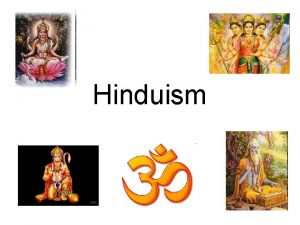The Hindu Caste System Hinduism is derived from



























![Varna Brahmins Kshatriyas Vaishyas Shudras Outcasts [Harijan] Untouchables Social Hierarchy Varna Brahmins Kshatriyas Vaishyas Shudras Outcasts [Harijan] Untouchables Social Hierarchy](https://slidetodoc.com/presentation_image/28e09bb86ca8a3fc04f8bb6aa72b3a8e/image-28.jpg)






- Slides: 34

The Hindu Caste System

Hinduism is derived from the Persian word “Hind” for “inhabitant of India”. It is different than Christianity and other religions because it does not have a single founder like Abraham or Jesus Christ. It grew over a period of 4, 000 years. Hinduism is composed of many different groups and has no welldefined organization. Its two most general features are the caste system and acceptance of the Vedas as the sacred scriptures.

Hinduism Many outsiders influenced the development of Hinduism, especially the Aryans, who came to India in 1500 and brought with them their religion of Vedism and the Vedas, their sacred scriptures. These beliefs became mixed with the Indian beliefs to form the Hindu religion.

The Vedas are some of the oldest written text on our planet. They date back to the beginning of Indian civilization and are the earliest literary records of the Aryan race. They were written between 4 -6, 000 years ago in an ancient language called Sanskrit. The Vedas are divided into four groups, Rigveda, Yajurveda, Samaveda and Atharvaveda and are full of hymn, rituals, religious practices and poems. Sanskrit

Hindu Trinity • Brahma - the Creator • Vishnu - the Preserver • Shiva - the Destroyer • Three aspects/powers of the same divine being • trinity

The Vedas The Rig Veda tells the story of Prajapati, the first god who created the world. Prajapati was sacrificed to himself by the younger gods Indra, Agni, and Varuna, and out of his body parts the whole universe was made. The Rig Veda says that the Prajapati’s body parts turned into different groups of people, so that Indian people thought of themselves as belonging to one of four castes, or groups. This idea of caste is an Aryan idea.

Scriptures Hundreds of scriptures oldest scriptures: the four Vedas all scriptures divided into two broad categories: shruti (that which is heard directly) and smriti (memorized tradition) Most popular scripture: Bhagavad Gita

Definition: A type of social organization/hierarchy in which a person’s occupation and position in life is determined by the circumstances of his birth or other factors over which he has no control.

Hinduism

The Caste System So, the Caste System began in India after the Aryans invaded and established their own rules for governing the society. The Aryans did not permit marriages between their own people and people of the cultures they conquered.

The Caste System Each caste had its own specific place in society. They socialized, ate, married, worked, and worshipped within their own caste. They would never consider marrying or working outside their caste.

Reincarnation A person is born, lives, dies, and is reborn again many times. Souls are reborn many times until they are pure enough to be with the creator, Brahma Karma A person’s social position in the next life is determined by his conduct in the present life.

Dharma Code of behavior or set of moral and ethical rules that govern the conduct of each social class. Each group has a different set of rules to live by. Laws of Manu Hindu book of sacred law Rules and restrictions for daily life

�Rigid, hereditary membership into birth caste �Marriage only among member of same caste �Occupation choices restricted �Personal contact with other castes restricted �Acceptance of fixed place in society

The Caste System The caste system, then, was based upon idea that people are different, so they should have different roles. From 1000 to 500 BC, four classes of people emerged in India. Really there are 5 groups, however the untouchables are considered so low that they aren’t even counted.

�Members of a caste rely on each other for support

�Each caste has an occupation(s) and contributes to the good of the whole �Jajman—gives gift (landlord) �Kamin—gives service to the landholder (lower castes)

Landholder gives grain to… Barber Blacksmith Priest Potter Carpenter Today…more of a market system

The castes upper class

BRAHMAN They are the priestly class, who are entitled to study the Vedas, which are the sacred scriptures, and perform rites rituals for themselves and for others. They are the men between the gods and the people. They are expected to show excellent behavior and spend their lives in the pursuit of divine knowledge and preservation the traditions of Hinduism.

KSHATRIYAS They are the warrior class, who are commanded to protect the people, give gifts to the Brahmins, offer sacrifices to gods and ancestors, study the Vedas, and dispense justice. It was their responsibility to protect the caste system and the social order and lavish the priests with generous gifts at every opportunity.

The castes middle class

VAISYAS They are the merchant and peasant classes, who are expected to tend cattle, offer sacrifices, study the Vedas, trade, lend money and farm the land. They had the right to perform and participate in certain Vedic rituals but they were not allowed to marry women of higher castes.

The castes lowest classes

SUDRAS The are the laboring class, whose only duty is to serve the other three castes. They were not required to observe any Vedic rituals. They were not allowed to study the Vedas or even hear the sacred chants. They were not allowed to eat food in the company of higher castes or marry their women.

SUDRAS HARIJAN also called Untouchables The lowest of the sudras were called harijan or the untouchables. They were outside of the caste system because of their religious practices, rites and unclean habits. In ancient times they were not allowed to enter a village or city during day time or walk in the same street where men of other castes walked.

SUDRAS HARIJAN also called Untouchables Even their shadow was considered impure and seeing an untouchable was considered bad luck. So they lived mostly on the edges of society, unknown and uncared for, and working in graveyards or as hunters, butchers and professional cleaners of human waste.
![Varna Brahmins Kshatriyas Vaishyas Shudras Outcasts Harijan Untouchables Social Hierarchy Varna Brahmins Kshatriyas Vaishyas Shudras Outcasts [Harijan] Untouchables Social Hierarchy](https://slidetodoc.com/presentation_image/28e09bb86ca8a3fc04f8bb6aa72b3a8e/image-28.jpg)
Varna Brahmins Kshatriyas Vaishyas Shudras Outcasts [Harijan] Untouchables Social Hierarchy

Varna WHO IS… § The mouth? Brahmins Kshatriyas § The arms? § The legs? Vaishyas § The feet? Shudras

Symbolism in Hinduism

Holy Cow! • Hindus have always had great respect for Mother Nature and its creatures • Cow is especially significant because it symbolizes gentleness

Four Goals of Human Life • Kama – fulfillment of desires • Artha – accumulation of wealth • Dharma – performance of social and religious duties • Moksha – freedom from want

Temple Worship • Temples provide an atmosphere conducive for spiritual progress • Centers of social and cultural activities • Provide a place for collective worship and prayers

Festivals • Hinduism is a celebratory religion • WHY? ? Festivals keep Hindus close to the gods, invigorate their households and renew their personal lives. • Festivals signify the victory of good over evil. • Every month of Hindu calendar has at least one significant festival. Each festival has regional significance also. • Each festival is a celebration of diversity
 Caste system
Caste system How many castes are there in india
How many castes are there in india Caste system versus class system
Caste system versus class system Religion and conflict theory
Religion and conflict theory 489 in roman numerals
489 in roman numerals Roman numerals rules
Roman numerals rules Hindu numbers
Hindu numbers Peninsulares
Peninsulares Spanish caste system in the americas
Spanish caste system in the americas The aryan caste system
The aryan caste system Sikh caste
Sikh caste Hinduism
Hinduism Aryan civilization
Aryan civilization What is the highest level of the indian caste system?
What is the highest level of the indian caste system? Valmiki caste
Valmiki caste Hinduism oldest religion
Hinduism oldest religion Aryans caste system
Aryans caste system Indian caste system names
Indian caste system names Sirswal caste category
Sirswal caste category Freud brave new world
Freud brave new world Brave new world caste colors
Brave new world caste colors Spanish caste system
Spanish caste system Indian social classes
Indian social classes Indian caste system pyramid
Indian caste system pyramid Caste system lesson plan
Caste system lesson plan Features of punjab
Features of punjab Shudras caste system
Shudras caste system Caste system definition
Caste system definition Why?
Why? Caste system in latin america
Caste system in latin america Caste system definition
Caste system definition Ancient egypt social hierarchy
Ancient egypt social hierarchy Caste system india
Caste system india Caste system india
Caste system india Caste vs class
Caste vs class
